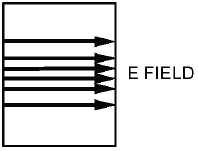1-19
(A)
(B)
(C)
Figure 1-25.—Wavefronts in a waveguide.
The reflection of a single wavefront off the "b" wall of a waveguide is shown in figure 1-26. The
wavefront is shown in view (A) as small particles. In views (B) and (C) particle 1 strikes the wall and is
bounced back from the wall without losing velocity. If the wall is perfectly flat, the angle at which it
strikes the wall, known as the angle of incidence ("), is the same as the angle of reflection (ø) and are
measured perpendicular to the waveguide surface. An instant after particle 1 strikes the wall, particle 2
strikes the wall, as shown in view (C), and reflects in the same manner. Because all the particles are
traveling at the same velocity, particles 1 and 2 do not change their relative position with respect to each
other. Therefore, the reflected wave has the same shape as the original. The remaining particles as shown
in views (D), (E) and (F) reflect in the same manner. This process results in a reflected wavefront
identical in shape, but opposite in polarity, to the incident wave.






